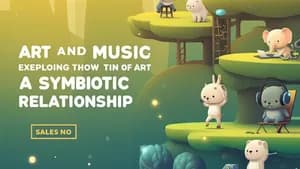Introduction: A Symphony of Influences
Art and music, two seemingly distinct forms of expression, have been intertwined throughout history, influencing and inspiring each other in countless ways. This intricate relationship, a vibrant tapestry woven through centuries, reveals how cultural shifts, technological advancements, and philosophical movements have shaped both artistic and musical landscapes. This article will explore this fascinating connection, demonstrating how artistic movements have been influenced by contemporary musical styles and vice-versa, providing you with insights that can enrich your understanding and appreciation of both art and music.
The Renaissance: A Rebirth of Harmony and Form
The Renaissance, a period of immense cultural flourishing in Europe, witnessed a remarkable synergy between art and music. The rediscovery of classical ideals, coupled with a renewed focus on humanism, profoundly impacted both disciplines. Think of the exquisite frescoes of the Sistine Chapel, Michelangelo’s powerful figures echoing the grandeur and emotional depth of Renaissance polyphony, the complex musical textures pioneered by composers like Josquin des Prez. The mathematical precision and balanced compositions in art found a parallel in the carefully structured harmonies and contrapuntal techniques of Renaissance music. You can explore this connection further by comparing the geometric patterns in Renaissance paintings to the formal structures of motets and masses. Consider analyzing the emotional weight of a painting alongside the mood evoked by a contemporary musical composition. This comparative analysis will help you grasp the interwoven essence of the era.
The Baroque: Drama, Ornamentation, and Emotional Intensity
The Baroque era (roughly 1600-1750) was defined by its dramatic intensity and ornate style, a characteristic shared by both artistic and musical expressions. In painting, the dynamic compositions of Caravaggio, with their use of light and shadow, mirror the passionate and theatrical nature of Baroque music. The virtuosity of composers like Bach and Handel, their complex counterpoint and elaborate ornamentation, finds a visual equivalent in the highly detailed and embellished art of the period. The use of dynamic contrasts, both in painting and music, conveyed a sense of emotional intensity and theatricality – a deliberate attempt to evoke strong reactions in the audience or viewer. For a deeper understanding, compare the dramatic use of light and shadow in a Caravaggio painting to the dynamic shifts in tone and volume in a Baroque concerto. Analyzing these similarities can provide a richer appreciation for the stylistic unity of the era.
The Romantic Era: Expression, Emotion, and Individuality
Romanticism, a powerful movement of the late 18th and 19th centuries, emphasized emotion, individuality, and the sublime. This shared emphasis is clearly visible in both the art and music of the time. Romantic paintings, with their focus on intense emotion, dramatic landscapes, and subjective experience, found a perfect counterpart in the expressive musical styles of composers like Beethoven, Chopin, and Liszt. Beethoven’s symphonies, with their powerful emotional range and innovative forms, are a powerful example of this artistic kinship. You could examine the use of color in Romantic paintings and compare it to the use of dynamics and harmonies in Romantic music to illustrate the shared emphasis on emotional expression. Similarly, tracing the themes of nature and the sublime across both artistic disciplines provides a valuable framework for comparative analysis.
The 20th and 21st Centuries: Modernity, Experimentation, and Beyond
The 20th and 21st centuries witnessed a radical shift in both art and music, with a move towards greater experimentation, abstraction, and a questioning of traditional forms. The rise of movements like Impressionism, Cubism, and Surrealism in art found echoes in the atonal and experimental music of composers like Schoenberg, Stravinsky, and Cage. The fragmentation of form and the exploration of new sonic textures in music mirrored the deconstruction of traditional perspectives in art. Consider analyzing the abstract forms of Kandinsky's paintings alongside the atonal compositions of Schoenberg; this will demonstrate how a rejection of traditional structures and the exploration of new aesthetic concepts created a shared artistic language across disciplines. You can delve deeper by studying how minimalist art parallels the simplicity and repetitive structures in minimalist music. Investigating these parallels will help you understand how these artistic revolutions redefined creative expression.
Conclusion: A Continuing Dialogue
The historical relationship between art and music is a rich and complex one, a continuous dialogue between two powerful forms of human expression. By understanding this interplay, you will gain a deeper appreciation for the nuances and complexities of both disciplines. Remember, the key to understanding this tapestry lies in engaging with the works themselves, comparing styles, themes, and techniques across different artistic movements. This comparative approach will enhance your understanding and foster a deeper appreciation for the fascinating interplay between art and music through time. Through active engagement and thoughtful analysis, you'll unlock a world of creative insight.

